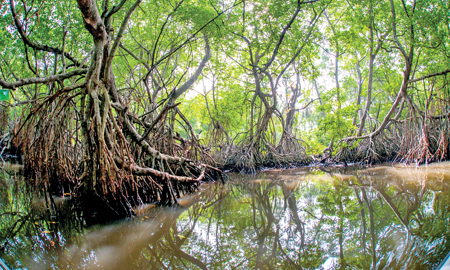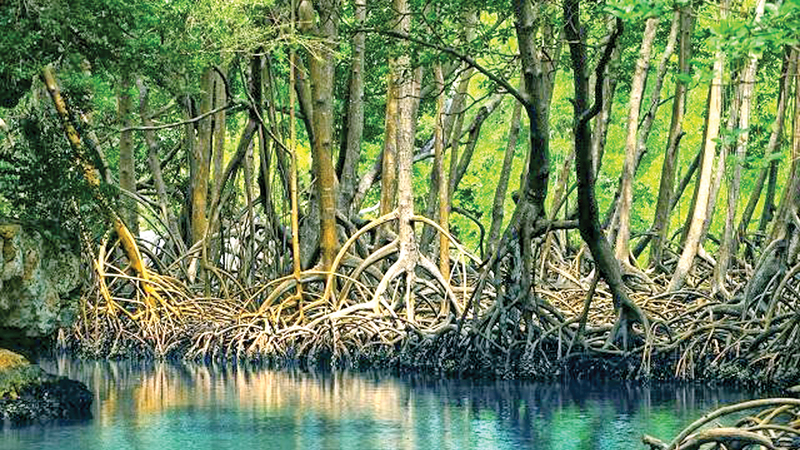Last month, Sri Lanka was recognised as one of the seven UN World Restoration Flagships for its pioneering and ambitious effort to restore and expand the island’s mangrove cover by over 50 percent.
The World Restoration Flagship awards are part of the UN Decade on Ecosystem Restoration led by the UN Environment Programme (UNEP) and the Food and Agriculture Organization of the UN (FAO).
Found on coastlines, mangrovesplay a critical role in disaster management, in ensuring a healthy environment, and in providing food security. Sri Lanka is home to 20 different species of mangroves.
According to slycantrust.org, mangroves survive in conditions under which other trees cannot, such as in salt water. And their extensive root systems create a unique environment for fish, birds, reptiles, amphibians, crustaceans, and many other animals and plants.
Mangrove forests offer sheltered habitats and nurseries for countless species of algae, seagrass, corals, oysters, barnacles, mollusks, shrimps, and crabs, as well as a hospitable environment for birds, bats, insects, water monitors, fishing cats and crocodiles.
Besides, mangroves are sources of wood, fibre, charcoal, and ingredients for cosmetics, perfumes, pharmaceuticals, and tanneries. One third of Sri Lanka’s population lives in coastal areas, and many of the inhabitants depend on mangroves for their livelihoods as fishers.
In the absence of mangroves,or upon their depletion, the coastline becomes vulnerable to sea surges, tsunamis and erosion. Carbon dioxide from the environment remains unabsorbed; and many species of marine life lose their habitat to the detriment of the coastal people’s food security.
Destruction of mangroves
In the past three decades, more than 50% of Sri Lanka’s mangroves had been destroyed due to prawn farming, hotels development, human settlements, logging, tourism, agriculture, and last but not the least, pollution.
According to www.theconversation.com a swelling appetite for shrimps and prawns in the US, Europe and Japan fuelled industrial farming of shellfish in the 1980s and 1990s across Asia, which is home to 40% of the world’s mangroves. The prawn industry was worth US$10billion per year globally at that time.
 Mangroves in Sri Lanka were destroyed on a mass scale due to the surge in pawn farms and the burgeoning market for prawns in Japan. Prawn exports accounted for approximately 50% of the total export earnings from Sri Lankan fisheries, with more than 90% of the harvested cultured prawns exportedmostly to Japan.
Mangroves in Sri Lanka were destroyed on a mass scale due to the surge in pawn farms and the burgeoning market for prawns in Japan. Prawn exports accounted for approximately 50% of the total export earnings from Sri Lankan fisheries, with more than 90% of the harvested cultured prawns exportedmostly to Japan.
While foreign exchange flowed in, the other side of the coin was not so pretty. Satellite imagery of Puttalam district from 1992 to 2012 showed an explosion in prawn farms with areas ranging from 40 hectares to over 1,100 ha. They also showed that mangroves were depleted in 36 percent of their area over the period.
Another significant observation was that many prawn farm ponds had become unproductive or had been abandoned. Ninety percent of ponds were idle. Shrimp exports had also declined by 65 percent between 1999 and 2012.
With prawn farms in and mangroves gone, nearly 192,000 additional tonnes of carbon were added to the environment in Puttalamdistrict alone. The other issue was the sinking shoreline. In the face of global rising sea levels of more than 3mm a year, healthy mangrove forests are among the best protection since they bind together sediments and even elevate their soils to match the rising tide. The absence or depletions of mangroves resulted in sea erosion.
Unregulated aquaculture resulted in poor coastal management which brought the “white spot syndrome virus”, a virulent disease that spreads in water and on the feet of birds, that could kill all the prawns in a pond in under a week.
It was the Boxing Day tsunami in December 2004 which brought about a significant change in the thinking about mangroves and prawn farming in Sri Lanka. The tsunami had claimed 30,000 lives in and destroyed a lot of property on the Lankan coast.
It was seen very clearly that mangroves could stem the tsunami and save lives. An article published www.reliefweb.int made a comparison between two coastal villages, Kapuhenwala and Wanduruppa, in southSri Lanka. In the Kapuhenwala area, surrounded by 200 hectares of dense mangroves and scrub forest, the tsunami killed only two people — the lowest number of tsunami related fatalities in a Sri Lankan village. But in Wanduruppa area, surrounded by degraded mangroves, the death toll was 5,000 to 6,000.
Speaking to www.theconversation.int in 2005, Achim Steiner, Director General of the World Conservation Union (IUCN) said: “Damage by the tsunami could have been prevented with a healthy mangrove barrier protecting the shoreline.
Now that the emergency is over, it is time to start reconstructing the environmental infrastructure of the region.”
Planting projects
The government lost no time and launched many mangrove planting projects with donor-support. But this was often done without proper technical knowledge or community involvement.
Out of 1,000-1,200 hectares of mangrove subjected to restoration, only 200-220 hectares survived. In 9 out of 23 planting sites, all the seedlings died due to inappropriate locations, unsuitable species, and a lack of post-planting monitoring and care.
Eventually, the approach changed from merely planting to conservationand nurturing. The Small Fishers Federation of Sri Lanka (which has a Mangrove Re-Plantation Advisory Board) or the University of Ruhuna, started using an inclusive approach that relies on local knowledge, technical expertise and the cooperation of local coastal communities.
In 2018, SLYCAN Trust, in collaboration with the Marine Environment Protection Authority (MEPA),initiated the “Blue-Green Protectors Project” bringing together local stakeholders, government agencies, university students, and youth to plant mangroves at multiple sites near Jaffna and Mannar and conduct environmental workshops.
Local knowledge from farmers combined with the technical expertise of MEPA, the University, and the government to produce good results.
Ecosystem restoration in Sri Lanka island is now science-driven, co-led by local communities, and focused on restoring the natural balance in the ecosystem.
 In this, international cooperation has been a key factor. The Australian and UK governments helped healthy mangrove growth over hundreds hectares.
In this, international cooperation has been a key factor. The Australian and UK governments helped healthy mangrove growth over hundreds hectares.
In 2015, Sri Lanka became the first nation to legally protect all its mangrove forests and established the National Expert Committee on Mangrove Conservation and Sustainable Use, spurring several actions to protect and manage mangroves. It is now illegal to cut mangroves in Sri Lanka. The island nation has become the world’s first country to protect the entirety of its mangrove forests.
The Sri Lankan Forest Department puts the extent of mangroves at 15,670 hectares based on a 2010 survey while IUCN estimates put mangrove cover at around 12,000 hectares. The majority of mangroves are in the districts of Puttalam, Jaffna, Trincomalee, and Batticaloa.
International recognition
These efforts and environmental accomplishments are recognised outside of Sri Lanka.
The Sri Lankan NGO Sudeesa, the Small Fishers Federation for women and young adults, focused on farming and fishing, grabbed the attention of Seacology, a California-based organization.
Seacology was established with the mission to fight for island conservation around the world. In 2015,Seacologydecided to narrow its focus on mangrove conservation.
Thanks to the inspiring work of Sudeesa, Seacology launched the Sri Lanka Mangrove Conservation Program, a non-profit program, the first nationwide conservation program for mangroves. It funded ecological protection of mangroves, and provided support for the citizens living in these areas.
In five years, the Seacology was able to map over 36,000 acres of mangroves and protected them from deforestation. By 2020, 1,200 acres of mangroves had been restored with the replanting of almost 1 million mangrove seedlings.
The project also established the world’s first mangrove museum as a popular ecotourism destination. The Lanka Mangrove Museum opened on July 26, 2016, a date also established as International Mangrove Day.
In 2020, the Government adopted a National Policy on Conservation and Sustainable Utilisation of Mangrove Ecosystems. . To maintain the sustainability of the policy, the “National Strategic Action Plan for Conservation and Sustainable Utilization of Mangroves in Sri Lanka” was developed in 2022, complemented by National Guidelines.
In 2022, the UN General Assembly adopted a resolution, sponsored by Sri Lanka, to celebrate March 1, as World Seagrass Day.
Recognised as a World Restoration Flagship, Sri Lanka’s mangrove restoration drive is now eligible for technical and financial UN support. This will bring it closer to realise its 2030 goal of restoring 10,000 hectares of mangroves – more than 50% of the country’s mangrove cover – to benefit 5,000 households and creating over 4,000 new jobs.
Sri Lanka expects to achieve its 2030 goals with additional funding of USD 3.5 million to support livelihood activities, maintain restoration sites and restore channels, as well as cleaning and boundary management, awareness raising and calculation of the value of carbon sequestered by the restoration of mangroves.




